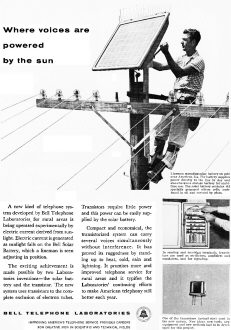|
January 1956 Radio-Electronics
 [Table of Contents] [Table of Contents]
Wax nostalgic about and learn from the history of early electronics.
See articles from Radio-Electronics,
published 1930-1988. All copyrights hereby acknowledged.
|
The trend toward solar
power is nothing new. Engineers and scientists have been working for decades to
develop photovoltaic (PV) cells for converting sunlight into electricity. The
challenge has been primarily a semiconductor compound and construction issue.
Modern high efficiency solar cells are not the simple silicon types of
yesteryear. Modern PV cells use a complex mixture of atoms and die layer
configurations. The process for today's most efficient examples is difficult and
expensive. There is also the problem of degrading performance over time with
continued exposure to sunlight and environmental contamination (dust, dirt,
rain, pollution chemicals, etc.). Newly installed array systems might boast
20%-25% efficiency, but five years later it is down measurably. After a decade
and longer things can get really bad. This Bell Telephone Labs infomercial
from a 1956 issue of Radio-Electronics magazine show a lineman
installing a "solar battery" atop a pole for powering remote lines. Similar
setups have long been common sights with roadside emergency phone boxes.
Bell Telephone Laboratories Ad
 Where voices are powered by the sun Where voices are powered by the sun
A new kind of telephone system developed by Bell Telephone Laboratories for rural
areas is being operated experimentally by electric current derived from sunlight.
Electric current is generated as sunlight falls on the Bell Solar Battery, which
a lineman is seen adjusting in position.
The exciting achievement is made possible by two Laboratories inventions - the
solar battery and the transistor. The new system uses transistors to the complete
exclusion of electron tubes. Transistors require little power and this power can
be easily supplied by the solar battery.
Compact and economical, the transistorized system can carry several voices simultaneously
without interference. It has proved its ruggedness by standing up to heat, cold,
rain and lightning. It promises more and improved telephone service for rural areas
and it typifies the Laboratories' continuing efforts to make American telephony
still better each year.
Lineman mounting solar battery on pole near Americus, Ga. The battery supplies
power directly to the line by day and also charges a storage battery for nighttime
use. The solar battery contains 432 specially prepared silicon cells, cushioned
in oil and covered by glass.
In sending and receiving terminals, transistors are used as oscillators, amplifiers
and regulators, and for signaling.
One of the transistors (actual size) used in the new system. New ideas, new tools.
new equipment and new methods had to be developed for this project.
Bell Telephone Laboratories
Improving America's Telephone Service Provides Careers for Creative men in Scientific
and Technical Fields
Posted November 15, 2022
|










